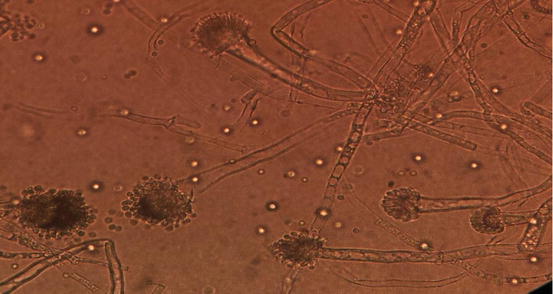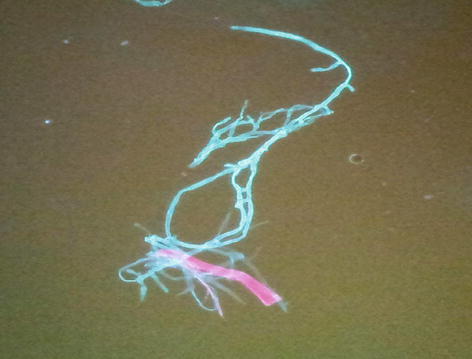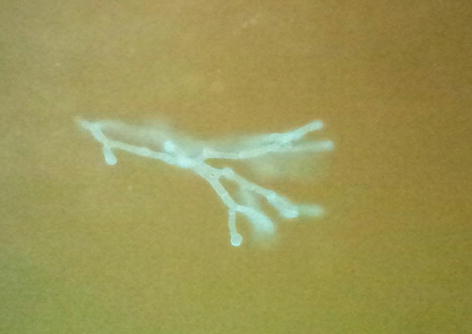Fig. 1
Subcutaneous (arrow) Conidiobolus rhinofacial infection
Basidiomycota includes Cryptococcus neoformans. This organism is an encapsulated yeast which can cause disease in immunocompetent individuals as well as immunosuppressed patients. Infection occurs following inhalation and meningitis is the most common presentation.
Deuteromycota (Fungi imperfecti) includes Candida spp., Coccidioides immitis, and Sporothrix schenckii. Candida species can cause both superficial and invasive infections. It is also part of the normal flora of the gastrointestinal tract.
Fungi isolated in invasive fungal rhinosinusitis while showing geographic variation are often similar in particular forms of fungal disease [5]. For example, A. fumigatus, A. flavus, and Rhizopus sp. are uniformly seen in patients with acute invasive disease worldwide [6–8].
Acute Invasive Fungal Rhinosinusitis
Two distinct patient populations are seen [9]: one group of patients is patients with diabetes, especially with diabetic ketoacidosis and second group with neutropenia. Up to 80 % of invasive fungal infections in the first group are caused by fungi belonging to the order Zygomycetes such as Rhizopus sp., Rhizomucor sp., Absidia sp., and Mucor sp. [10]. This disease is more rapidly progressive with high mortality and morbidity probably due to the high virulence of these fungi as well as due to diagnosis of the disease at a late stage [9].
The other group is immunocompromised patients with severe neutropenia, e.g., patients with hematologic malignancies; patients undergoing chemotherapy or systemic steroid therapy or bone, organ, or stem cell transplantation; or patients with AIDS. Aspergillus species is responsible for up to 80 % of infections in this group [10]. In India, A. flavus [11] is the most common (80 %) while in the Middle East, A. fumigatus [12] is the most common (50 %) causative agent. Nasal septal ulceration has also been described with Fusarium species and Pseudallescheria boydii.
Among the zygomycotic species causing IFS, Rhizopus arrhizus is the most frequent agent followed by Rhizopus microsporus, Absidia corymbifera, Rhizomucor pusillus, and Mucor circinelloides [13, 14]. Another agent, Apophysomyces elegans, is also responsible for zygomycosis in India [1]. Sridhara et al. [15] have reported an increasing trend of mucormycosis in immunocompetent individuals. Three out of eight immunocompetent cases reported by them were infected by Apophysomyces elegans [15].
Wueppenhorst et al. [16] have reported a case of fulminant invasive fungal sinusitis caused by Conidiobolus incongruus in Germany. They concluded that diagnostics relying exclusively on histopathological findings could misdiagnose entomophthoramycosis as mucormycosis, and therefore, species identification is indispensable for collection of data for the adequate treatment of the condition.
Chronic Invasive Fungal Rhinosinusitis
Aspergillus species, dematiaceous molds such as Bipolaris, Curvularia, and Pseudallescheria boydii are the fungi implicated in this disease. Aspergillus fumigatus is the most commonly isolated fungus [17] although Mucor sp. is also known to be a causative agent especially in diabetics.
Chronic Granulomatous Rhinosinusitis
Aspergillus flavus is the fungus most often implicated in this disease. Paranasal granuloma is a peculiar syndrome associated with proptosis that has also been called indolent fungal sinusitis in immune competent persons. The fungus A. flavus shows exuberant growth with regional tissue invasion, non-caseating granulomas, giant cells, and plasma cells. This condition is known to occur in Saudi Arabia, Sudan, India, and Pakistan [11, 18]. This is rarely seen in the USA [19].
Diagnosis
Specimen – Tissue samples or aspirates are recommended as opposed to swabs as the material obtained in tissue and aspirate is much more than in swabs, thus increasing the yield.
Microscopy
KOH Wet Mount
Potassium hydroxide digests proteinaceous material and debris and allows visualization of the fungal hyphae under a light microscope (Fig. 2).



Fig. 2
KOH mount of Aspergillus

Fig. 3
Calcofluor preparation of aseptate fungal filaments
Calcofluor Staining
It is difficult to stain fungi with routine stains, but this stain binds to the chitin and cellulose in the fungal cell wall and demonstrates bright green to blue fluorescence under a fluorescent microscope making it easier to demonstrate the fungi (Figs. 3 and 4). Sensitivity increased by 15 % in demonstrating fungal hyphae when calcofluor white was added to KOH wet mounts in a Chinese study on fungal keratitis [22]. For rapid diagnosis, clinicians should request for calcofluor/KOH mount.


Fig. 4
Calcofluor preparation of septate fungi
Lactophenol cotton blue is a widely used method of staining and observing fungi (Figs. 5a, b and 6). On microscopy one can comment on the presence or absence of septae. Aseptate fungi are Mucorales (Fig. 3). Septate fungi are Aspergillus sp., Fusarium spp., Scedosporium spp., etc. (Fig. 4). Aspergillus spp. demonstrates acute angle branching and Mucorales demonstrates right angle branching. Practically, it may be difficult to comment on the branching pattern.
Stay updated, free articles. Join our Telegram channel

Full access? Get Clinical Tree


